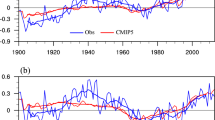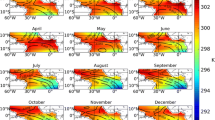Abstract
The atmospheric response to the AMOC variability is investigated in the IPSL-CM5A medium resolution climate model, using lagged maximum covariance analysis (MCA) of a control simulation. A robust atmospheric response is detected in winter, with a negative NAO-like response following by about 9-year an AMOC intensification in the North Atlantic, with a pattern broadly resembling the second mode of AMOC variability. The response is established through the SST footprint of the AMOC and the associated surface heat flux damping, with a dipole of SST anomalies made of cold SST in the Gulf Stream region and warm SST further northeast around the North Atlantic Current. The dipole SST anomaly pattern evolves synchronously with the AMOC changes at its dominant 20-year period, so that the lagged NAO-like response detected by MCA actually reflects the near-synchronous AMOC influence on the atmosphere, which is masked at short time lag by the stronger atmospheric forcing of the AMOC. The atmospheric response to an intensification of the AMOC is thus a positive NAO-like pattern, together with an anomalous low pressure over the Aleutians, opposite to that detected at 9-year lag by the MCA. Since the NAO also contributes to force the AMOC, there is a positive feedback between AMOC and NAO in the model, with the atmospheric feedback strength about 1/4 of that of the atmospheric forcing, which enhances the low frequency variability of AMOC. This is further confirmed by the lead-lag relation between the dominant mode of ocean and atmosphere, and by the robust 20-year period of the NAO.












Similar content being viewed by others
References
Arakelian A, Codron F (2012) Southern hemisphere jet variability in the IPSL GCM at varying resolutions. J Atmos Sci 69(12):3788–3799
Banta JR, McConnell JR (2007) Annual accumulation over recent centuries at four sites in central Greenland. J Geophys Res. doi:10.1029/2006JD007887
Barnes EA, Polvani L (2013) Response of the midlatitude jets, and of their variability, to increased greenhouse gases in the CMIP5 models. J Clim 26(18):7117–7135
Booth BB, Dunstone NJ, Halloran PR et al (2012) Aerosols implicated as a prime driver of twentieth-century North Atlantic climate variability. Nature 484:228–232
Bretherton CS, Smith C, Wallace JM (1992) An intercomparison of methods for finding coupled patterns in climate data. J Clim 5:541–560
Cayan DY (1992) Latent and sensible heat flux anomalies over the northern oceans: driving the sea surface temperature. J Phys Oceanogr 22:859–881
Cheng X, Dunkerton TJ (1995) Orthogonal rotation of spatial patterns derived from singular value decomposition analysis. J Clim 8:2631–2643
Czaja A, Frankignoul C (2002) Observed impact of Atlantic SST anomalies on the North Atlantic oscillation. J Clim 15:606–623
Delworth TL, Greatbatch RJ (2000) Multidecadal thermohaline circulation variability driven by atmospheric surface flux forcing. J Clim 13:1481–1495
Deser C, Tomas RA, Peng SL (2007) The transient atmospheric circulation response to North Atlantic SST and sea ice anomalies. Clim Dyn 20:4751–4767
Deshayes J, Frankignoul C (2008) Simulated variability of the circulation in the North Atlantic from 1953 to 2003. J Clim 21:4919–4933
Dong B, Sutton RT (2005) Mechanism of interdecadal thermohaline circulation variability in a coupled ocean–atmosphere GCM. J Clim 18:1117–1135
Dufresne J, Foujols S, Denvil S et al (2013) Climate change projections using the IPSL-CM5 earth system model: from CMIP3 to CMIP5. Clim Dyn 40:2123–2165
Eden C, Willebrand J (2001) Mechanism of interannual to decadal variability of the North Atlantic circulation. J Clim 14:2266–2280
Escudier R, Mignot J, Swingedouw D (2013) A 20-year coupled ocean-seaice-atmosphere variability mode in the North Atlantic in an AOGCM. Clim Dyn 40:619–636
Farneti R, Vallis GK (2009) Mechanisms of interdecadal climate variability and the role of ocean–atmosphere coupling. Clim Dyn. doi:10.1007/s00382-009-0674-9
Frankcombe L, Dijsktra HA, von der Heydt A (2008) Sub-surface signatures of the Atlantic Multidecadal Oscillation. Res. Lett, Geophys. doi:10.1029/2008GL034989
Frankcombe L, von der Heydt A, Dijsktra HA (2010) North Atlantic multidecadal climate variability: an investigation of dominant time scales and processes. J Clim 23:3626–3638
Frankignoul C, Hasselmann K (1977) Stochastic climate models, part II application to sea-surface temperature anomalies and thermocline variability. Tellus 29(4):289–305
Frankignoul C, Kestenare E (2002) The surface heat flux feedback. Part I: estimates from observations in the Atlantic and the North Pacific. Clim Dyn 19:633–647
Frankignoul C, Czaja A, Heveder B (1998) Air–sea feedback in the North Atlantic and surface boundary conditions for ocean models. J Clim 11:2310–2324
Frankignoul C, Gastineau G, Know YO (2013) The influence of the AMOC variability on the atmosphere in CCSM3. J Clim 26:9774–9790
Ganachaud A, Wunsch C (2003) Large-scale ocean heat and freshwater transports during the World Ocean Circulation Experiment. J Clim 16:696–705
Gastineau G, Frankignoul C (2012) Cold-season atmospheric response to the natural variability of the Atlantic meridional overturning circulation. Clim Dyn 39:37–57
Gastineau G, Frankignoul C (2015) Influence of the North Atlantic SST variability on the atmospheric circulation during the twentieth-century. J Clim, Accepted
Hodson D, Sutton R, Cassou C et al (2010) Climate impacts of recent multidecadal changes in Atlantic Ocean sea surface temperature: a multimodel comparison. Clim Dyn 34:1041–1058
Hoskins B, Valdes P (1990) On the existence of storm tracks. J Atmos Sci 47:1854–1864
Huck T, Verdiere AC, Weaver AJ (1999) Interdecadal variability of the thermohaline circulation in box-ocean models forced by fixed surface fluxes. J Phys Oceanogr 29:865–892
Johns W et al (2011) Continuous, array-based estimates of the Atlantic Ocean heat transport at 26.5N. J Clim 24:2429–2449
Jungclaus J, Haak H, Latif M et al (2005) Arctic-North Atlantic interactions and multi-decadal variability of the meridional overturning circulation. J Clim 18:4013–4031
Knight J, Allan R, Folland C et al (2005) A signature of persistent natural thermohaline circulations in observed climate. Geophys Res Lett 32:L20708. doi:10.1029/2005GL024233
Kwon Y, Frankignoul C (2014) Mechanisms of multidecadal Atlantic meridional overturning circulation variability diagnosed in depth versus density space. J Clim 27(24):9359–9376
Latif M, Roeckner E, Botzet M et al (2004) Reconstructing, monitoring and predicting multidecadal-scale changes in the North Atlantic thermohaline circulation with the sea surface temperature. J Clim 17:1605–1614
Liu Z (2012) Dynamics of interdecadal climate variability: a historical perspective. J Clim 25:1963–1995
MacMartin D, Tziperman E, Zanna L (2013) Frequency domain multimodel analysis of the response of atlantic meridional overturning circulation to surface forcing. J Clim 26(21):8323–8340
Marini C, Frankignoul C (2013) An attempt to deconstruct the Atlantic multidecadal oscillation. Clim Dyn 43:607–625. doi:10.1007/s00382-013-1852-3
McCarthy G, Frajka-Williams E, Johns WE, Baringer MO et al (2012) Observed interannual variability of the Atlantic meridional overturning circulation at 26.5N. Geophys Res Lett. doi:10.1029/2012GL052933
Mignot J, Ganopolski A, Levermann A (2007) Atlantic subsurface temperature: response to a shutdown of the overturning circulation and consequences for its recovery. J Clim 20:4884–4898
Msadek R, Frankignoul C (2009) Atlantic multidecadal oceanic variability and its influence on the atmosphere in a climate model. Clim Dyn 33:45–62
Ortega P, Mignot J, Swingedouw D, et al. (2015) Reconciling two alternative mechanisms behind bi-decadal variability in the North Atlantic. Prog Oceanogr 137:237–249
Ottera OH, Bentsen M, Drange H, Suo L (2010) External forcing as a metronome for Atlantic multidecadal variability. Nat Geosci 3:688–694
Pohlmann H, Sienz F, Latif M (2006) Influence of the multidecadal Atlantic meridional overturning circulation variability on European climate. J Clim 19:6062–6067
Rayner D et al (2011) Monitoring the Atlantic meridional overturning circulation. J Clim 58:1744–1753
Rodwell DP, Folland CK, Maskell K, Ward MN (1995) Variability of summer rainfall over tropical north Africa (1906–92): observations and modeling. Q J R Meterorol Soc 121:669–704
Sévellec F, Fedorov A (2013) The leading, interdecadal eigenmode of the Atlantic meridional overturning circulation in a realistic ocean model. J Clim 26(7):2160–2183
Sévellec F, Huch T (2015) Theoretical investigation of the Atlantic multidecadal oscillation. J Phys Oceanogr 45(9):150413133522004. doi: 10.1175/JPO-D-14-0094.1
Sutton RW, Hodson DLR (2005) Atlantic ocean forcing of North American and European summer climate. Science 309:115–118
Teng H, Branstator G, Meehl G (2011) Predictability of the Atlantic overturning circulation and its associated surface patterns in two CCSM3 climate change ensemble experiments. J Clim 24:6054–6076
Timmermann A, Latif M, Voss R et al (1998) Northern hemispheric interdecadal variability: a coupled air–sea mode. J Clim 11:1906–1931
Ting M, Kushnir Y, Li C (2014) North Atlantic Multidecadal SST Oscillation: external forcing versus internal variability. J Mar Syst 133:27–38
Vellinga M, Wu P (2004) Low-latitude freshwater influence on centennial variability of the Atlantic thermohaline circulation. J Clim 17:4498–4511
Wen N, Liu Z, Liu Q, Frankignoul C (2010) Observed atmospheric responses to global SST variability modes: a unified assessment using GEFA. J Clim 23:1739–1759
Yeager S, Danabasoglu G (2014) The origins of late-twentieth-century variations in the large-scale North Atlantic circulation. J Clim 27:3222–3246
Yeager S, Karspeck A, Danabasoglu G et al (2012) A decadal prediction case study: late twentieth-centrury North Atlantic Ocean heat content. J Clim 25:5173–5189
Acknowledgments
I’d like to thank Drs. Mignot J, Li ZX, Liu ZY and Otega P. for the helpful discussions. We thank the ciclad facility supported by CNRS, UPMC, Labex L-IPSL funded by the ANR (Grant #ANR-10-LABX-0018) and by the European FP7 IS-ENES2 project (Grant #312979). This work is supported by China Scholarship Council (CSC), the European Union 7th Framework Programme (FP7 2007-2013) under Grant Agreement Nos. 308299(NACLIM) and NSFC41475089.
Author information
Authors and Affiliations
Corresponding author
Rights and permissions
About this article
Cite this article
Wen, N., Frankignoul, C. & Gastineau, G. Active AMOC–NAO coupling in the IPSL-CM5A-MR climate model. Clim Dyn 47, 2105–2119 (2016). https://doi.org/10.1007/s00382-015-2953-y
Received:
Accepted:
Published:
Issue Date:
DOI: https://doi.org/10.1007/s00382-015-2953-y




